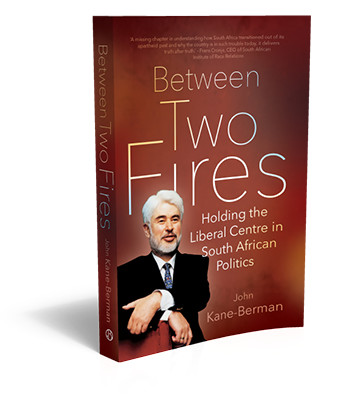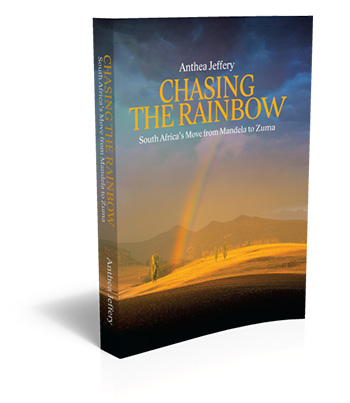Books
A time traveller's guide to South Africa in 2030
 The scenarios explain what this means for our future and what South Africa will look like in 2030. Will a spark ignite the powder keg? Will South Africa take the socialist route and allow the state to seize all wealth and land? Will the status quo prevail, and the wealth divide widen while crime soars? Do we face a pernicious erosion of our democratic rights and freedoms? Or will a rainbow rise unexpectedly?
The scenarios explain what this means for our future and what South Africa will look like in 2030. Will a spark ignite the powder keg? Will South Africa take the socialist route and allow the state to seize all wealth and land? Will the status quo prevail, and the wealth divide widen while crime soars? Do we face a pernicious erosion of our democratic rights and freedoms? Or will a rainbow rise unexpectedly?
The book is the second in a trilogy of books that have been planned to map the route South Africa will take to its next economic and political transition. The trilogy is based on doctoral research conducted by IRR CEO, Frans Cronje. The first book in the trilogy was published in 2014 as A Time Traveller’s Guide to Our Next Ten Years. The third book will be published within a year of the 2019 election. The books use first-hand political information and deep-dive economic and social research to predict how South Africa’s long-term future will evolve.
Briefings on the scenarios have become a staple of the strategic planning efforts of groups invested in South Africa. Briefings should be booked through Sherwin van Blerk and can be conducted in your office.
Clem Sunter described A Time Traveller's Guide to South Africa in 2030 as ‘masterful’.
Between Two Fires: Holding the Liberal Centre in South African Politics
 The breadth and depth of ideas and events covered in Between Two Fires are striking: the disintegration of apart- heid, the chaos of the ‘people’s war’ and its contribution to the broader societal breakdown we see today, the liberal slideaway, the rise of an authoritarian ANC with its racial ideology and revolutionary goals, to mention only a few. It is a book full of fizzing ideas.
The breadth and depth of ideas and events covered in Between Two Fires are striking: the disintegration of apart- heid, the chaos of the ‘people’s war’ and its contribution to the broader societal breakdown we see today, the liberal slideaway, the rise of an authoritarian ANC with its racial ideology and revolutionary goals, to mention only a few. It is a book full of fizzing ideas.
Kane-Berman’s willingness to confront received wisdom is thoroughly refreshing, and he is forthright about the threats to freedom, democracy, and growth in contemporary South Africa, many of which he identified even before the ANC came to power. He is equally forthright in putting forward liberal ideas to halt the country’s downward slide. Writing, debate, and reasoned argument are Kane-Berman’s stock in trade, and his clarity of vision and personal insight have created a memoir of rare candour and absorbing interest.
"A missing chapter in understanding how South Africa transitioned out of its apartheid past and why the country is in such trouble today, it delivers truth after truth." - Frans Cronje, CEO of South African Institute of Race Relations
You can buy the book from Exclusive Books, Takealot or as an e-book on Amazon.
BEE: Helping or Hurting?
 South Africa has arguably the most comprehensive and challenging affirmative action policies of any country in the world.
South Africa has arguably the most comprehensive and challenging affirmative action policies of any country in the world.
But is black economic empowerment (BEE) achieving its goal of correcting past injustices and opening up opportunities for black South Africans? Or is it in practice more harmful than helpful?
In the first comprehensive review of BEE policies since 1994, respected political analyst Anthea Jeffery tackles this question head-on. She examines affirmative action in education and employment, along with the BEE generic codes and BEE in mining, the oil industry, and elsewhere. Dr. Jeffery also deals with land reform.
The book is unique in drawing all the different aspects of BEE together and explaining often complex rules in simple layman’s terms. Dr. Jeffery also asks the challenging questions about the pros and cons of BEE that most commentators avoid.
How rapidly would the black middle class have grown without BEE? How much has BEE eroded South Africa’s growth potential or otherwise cost the country? Since current rules are unlikely to assist the marginalised, has the time not come to shift from BEE to a new system of EED – or ‘economic empowerment for the disadvantaged’?
People's War: New Light on the Struggle for South Africa
 As the people’s war accelerated from September 1984, intimidation and political killings rapidly accelerated. At the same time, a remarkably effective propaganda campaign put the blame for violence on the National Party government and its alleged Inkatha surrogate. Sympathy for the ANC soared, while its rivals suffered crippling losses in credibility and support.
As the people’s war accelerated from September 1984, intimidation and political killings rapidly accelerated. At the same time, a remarkably effective propaganda campaign put the blame for violence on the National Party government and its alleged Inkatha surrogate. Sympathy for the ANC soared, while its rivals suffered crippling losses in credibility and support.
By 1993 the ANC was able to dominate the negotiating process, as well as to control the (undefeated) South African police and army and bend them to its will. By mid-1994 it had trounced its rivals and taken over government.
Since 1994, many books have been written on South Africa’s political transition, but none deals adequately with the people’s war. The Truth and Reconciliation Commission should have covered this, but it largely overlooked it.
This book shows the extraordinary success of people’s war in giving the ANC a virtual monopoly on power. It also shows, in part at least, the great cost at which this was achieved. Apart from the killings, the terror, and the destruction that marked the period from 1984 to 1994, the people’s war set in motion forces that cannot easily be reversed. For violence cannot be turned off ‘like a tap’, as the ANC suggested, and neither can anarchy easily be converted into order.
Published by Jonathan Ball
Chasing the Rainbow: South Africa’s Move from Mandela to Zuma
 This book explains how South Africa has moved from the Mandela era to the Zuma one. It does so by reference to ten crucial policy areas which it terms the ‘ten pillars of democracy’.
This book explains how South Africa has moved from the Mandela era to the Zuma one. It does so by reference to ten crucial policy areas which it terms the ‘ten pillars of democracy’.
The ‘ten pillars’ range from individual rights and racial goodwill to growth-focused policies, free enterprise, and good citizenship. Scores assigned to each pillar provide a shorthand way of summing up the country’s performance from May 1994 to April 2009 and mark the start of a new annual monitor of democracy, the ‘Rainbow’ index.
Writes Rian Malan, author of My Traitor’s Heart and Resident Alien:
The book you’re holding contains a vanishingly rare and valuable commodity. You could call it information, I suppose, but that’s misleading… The commodity we lack is clarity, and that’s what Anthea Jeffery provides in Chasing the Rainbow.
At its simplest level, Chasing the Rainbow is a dispassionate assessment of South Africa’s progress since l994 in ten critical areas, ranging from the rule of law and effective governance to liberating the poor and fighting crime. Jeffery hands out plaudits where merited, but for the most part, her analysis reveals a country struggling desperately to fulfil the hopes that attended the dawn of the Rainbow era…
But all is not lost. As Jeffery notes, South Africa is a democratic country with a vigorous free Press. As our problems mount, debate has intensified, and the process might yet reveal solutions. Jeffery’s great achievement in this book is a precise and clinical dissection of those problems. As such, it could be a critical part of our salvation.
Anthea Jeffery holds law degrees from the University of the Witwatersrand and from Cambridge, and a doctorate in human rights law from the University of London. Her previous books include Business and Affirmative Action, The Truth about the Truth Commission and People’s War: New Light on the Struggle for South Africa.
The Long Shadow of Apartheid

South Africa is a country obsessed by race. Yet beyond the coverage of high-profile incidents and statements, and our individual experiences, we know relatively little about the state of race relations – about the way in which people of different races view and treat one another. Have race relations got better since 1994? What factors influence race relations? Is South Africa drifting towards a race war, as some have predicted? Why does race dominate political discourse so many years after the end of apartheid? Why have some of the most high-profile incidents of alleged racism in recent years involved people too young to remember racial segregation? Are race relations in South Africa’s farming communities at breaking point?
Improving race relations and erasing the legacy of racial division left by apartheid is likely to be a slow process. This work assesses what progress has been made over the last 15 years, and in doing so exposes the important role politicians, the media, and civil society can play in improving – or worsening – relations between the races.

 South Africa is currently at a tipping point. Unemployment, slow growth, threats to freedom of speech, and poor education can send the country in any direction. Frans Cronje, CEO of the IRR, identifies the key trends in the economy, politics and society which hold the clues to our immediate future.
South Africa is currently at a tipping point. Unemployment, slow growth, threats to freedom of speech, and poor education can send the country in any direction. Frans Cronje, CEO of the IRR, identifies the key trends in the economy, politics and society which hold the clues to our immediate future.